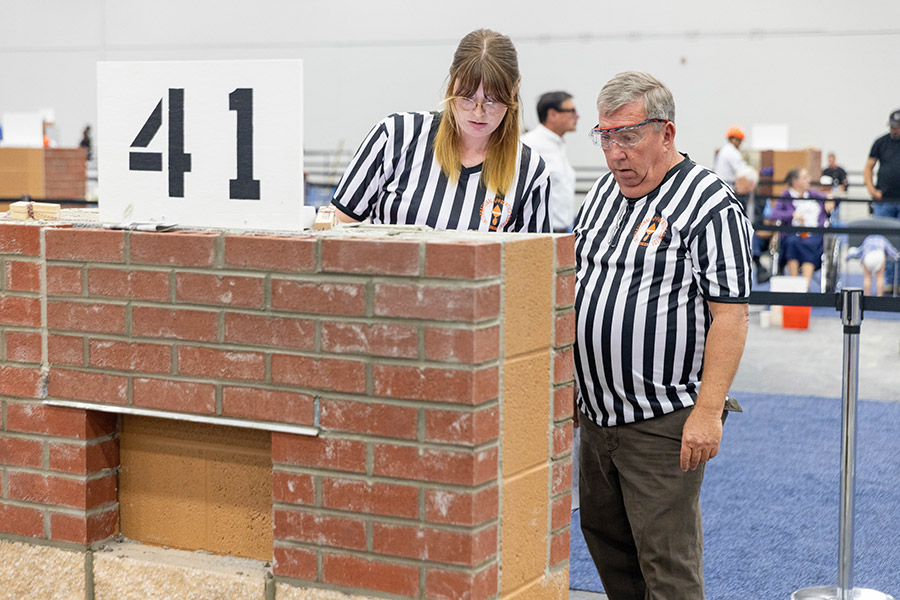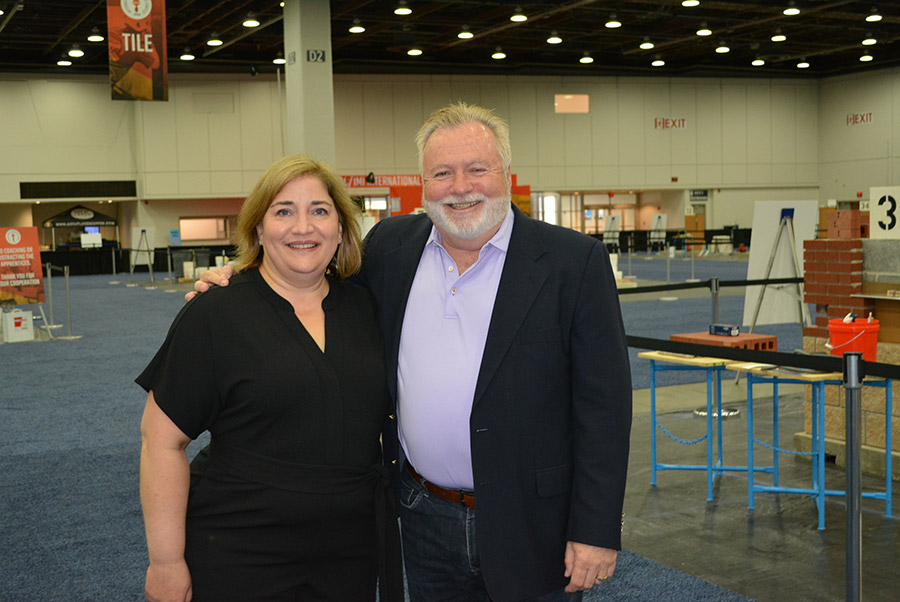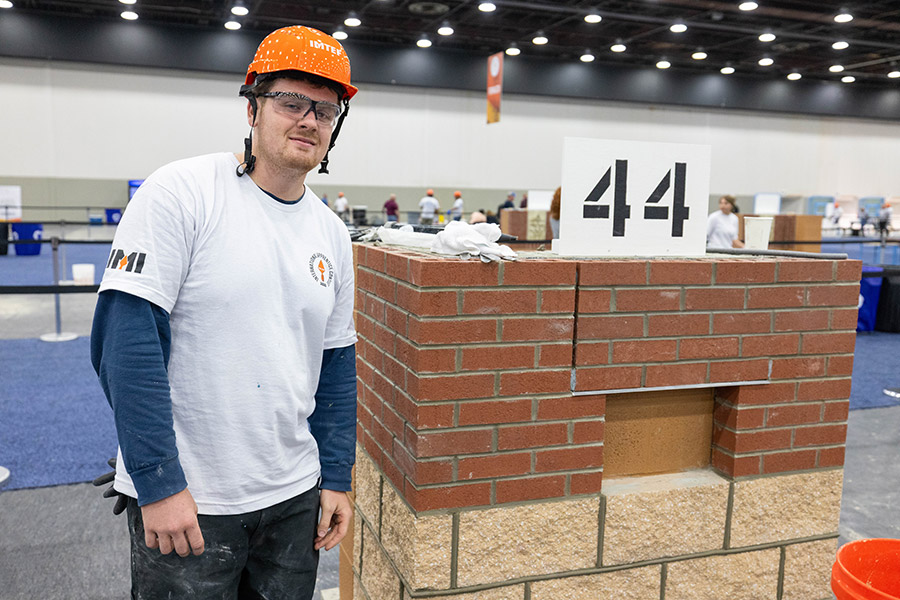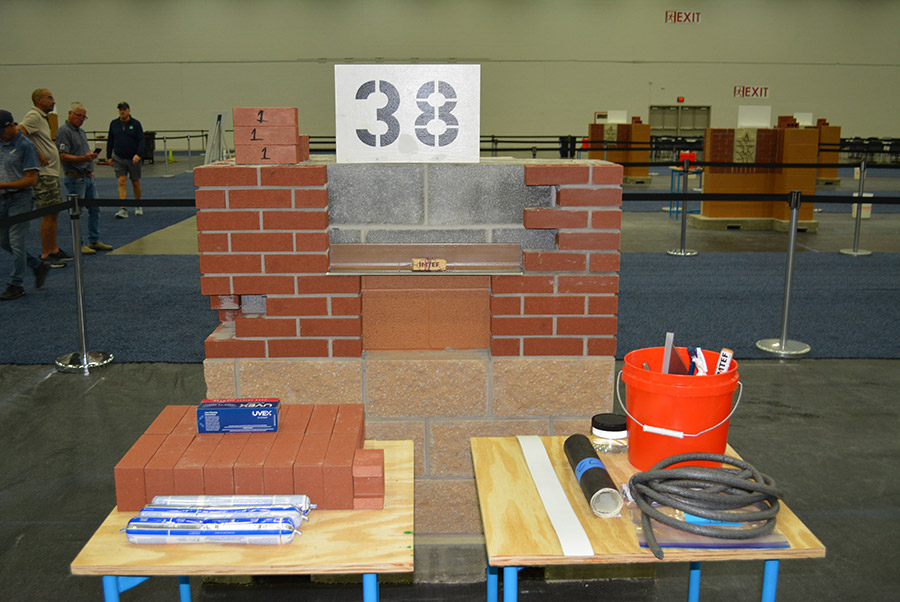Masonry Competition Breaks Down Career Entry Barriers for Aspiring Construction Professionals
The sound of clanging trowels and humming saws created a syncopated rhythm as more than 80 apprentices from across the U.S. and Canada last month squared off in the BAC/IMI International Apprentice Contest at Detroit’s Huntington Place convention center.
Competing in eight trades—brick, terrazzo, tile, plaster, stone, marble, cement and restoration—apprentices raced against the clock as they built intricate mock-ups in front of judges assessing their work for precision, safety and craft mastery. Jointly staged by the International Union of Bricklayers and Allied Craftworkers (BAC) and the International Masonry Institute (IMI), organizers of the Sept. 26-27 event say the contest aims to be a skills showcase and a demonstration of how labor unions can successfully train and supply the next generation of craftworkers in a time of acute need.
Yet for the competing apprentices, the triannual contest has become a way for them to break down barriers to enter the construction industry and jumpstart their careers.
“Apprentices are getting a lot more than craft training—they go through robust safety training, they’re working with the latest tools and materials, and our programs are constantly adapting to industry needs,” says Caryn Halifax, IMI president. “This contest is really a testament to the collaboration of labor and management.”

Showcasing the ‘Best of the Best’
Apprenticeships for bricklayers and allied craftworkers trades last two to four years, and the BAC/IMI International Apprentice Contest is staggered on a three-year cycle so nearly every apprentice has a chance to qualify. “It’s really the best of the best from across the U.S. and Canada,” Halifax said.
Among the best was 26-year-old John Deslippe of Philadelphia, a restoration/pointer caulker cleaner (PCC) apprentice with BAC Local 1 Pennsylvania-Delaware who won first place in the category during the contest.
“Just competing against other people who are on the same level as me, they take it as serious as I do, it felt good to surround myself with that,” says Deslippe, who says he hopes to use his apprenticeship to secure a career that would allow him to work with his hands.
“I like how learning a trade is sort of a lifelong thing. There is always something new to learn, and I think that intrigues me,” says adds.
For 19-year-old Trenton Lampkin, who placed first in the stone category, he says going straight into the workforce out of high school has helped fast-track his skills. As an apprentice with the Bricklayers & Allied Craftworkers Administrative District Council of Eastern Missouri, Lampkin does work for his dad’s bricklaying company and went into the contest aiming to showcase that he’s ready for the next stage.
“Whenever I do something I tell myself i want to be the best that I can be at it, so my first thought was I want to go win it,” says Lampkin, who encourages other people on the fence about entering the skilled trades to “find something you like to do and go be your best at it.”
Chelsea Collson, 33, competed in the 2022 International Apprentice Contest and returned this year as a judge for the Western Region and in the International Contest. “It was a lot less stressful,” quips Collson, a restoration/PCC specialist and foreperson in Portland with BAC Local 1 Oregon/Washington/Idaho/Montana.
“We’re looking for correct procedure, making sure they are actually doing the task the way we’ve trained them to do them. We are also looking for a beautiful finished product,” she says. Beyond the contest prizes attached to placing first, second or third in the competition, Collson says the event is a chance for the next generation of craftworkers to network with industry leaders and veterans who can aide them in their career growth.
“Every single one of us that competes are in the direct line of site from our IMI international Executive Board, from the leaders of our training,” says Collson. “Having the experience of being in front of them and being able to talk to them and mingle with people that you would have never seen is immeasurable.”
She adds, “it’s a big leg up as far as career building goes.”

Caryn Halifax, president of the International Masonry Institute, and Mike Schmerbeck, owner of Back Brook Masonry in New Jersey and IMI’s management chair, were on hand the day before the competition when nationwide apprentices competed in the triannual event.
A Critical Talent Pipeline
For contractors, the event underscores how much rides on the apprenticeship pipeline. Mike Schmerbeck, owner of Back Brook Masonry in New Jersey and IMI’s management chair, said contractors depend on it to deliver safe, productive workers. “The lifeline of this is our apprenticeship program,” he said. “The apprentices here are the best of the best, and they’re our future.”
He estimated the masonry industry will need to add 20,000 to 30,000 workers over the next five years to meet demand. Nationally, median wages for masonry trades remain competitive. Brickmasons and blockmasons earn a median of $59,640 annually, according to May 2024 Bureau of Labor Statistics data, with the top 10% topping $91,000. Cement masons earn a median of $53,100, while tile and marble setters earn $49,590 and plasterers and stucco masons earn $55,900.
Schmerbeck said steady union bricklayers can top $100,000 annually, with foremen reaching $200,000. “Beyond that is pride,” he added. “You load your kids in the car and show them the building you worked on. That’s something you can’t put a value on.”
Both Halifax and Schmerbeck stressed how safety has become embedded in training and jobsite culture. “Last year, there were a lot of scaffold safety incidents, so we elevated scaffold safety training and trained instructors to deliver it locally,” Halifax said. Schmerbeck described safety as the third “leg of the stool” alongside quality and productivity. “The beautiful thing about young people coming out of the apprenticeship program is they’ve been taught the right way. They know no other way, and they’re a breath of fresh air on a job site,” he said. His company’s improved safety performance, he added, saves $300,000 a year in workers’ compensation costs.

Among the best was 26-year-old John Deslippe of Philadelphia, who won first place in the restoration/pointer caulker cleaner category.
An Evolving Skill
Despite perceptions of masonry as timeless, Halifax emphasized that the industry is rapidly innovating. “You think about a brick as a brick, but there’s been a lot of modifications,” she said, citing carbon-capture block, algae-based binders, lighter-weight replacement terracotta and kilns fueled by sawdust or solar instead of coal. Schmerbeck noted that brick is resurging in New York City towers after decades of glass façades. “People like it—it’s tactile, it’s local, and it feels permanent,” he said. Halifax also tied the competition to retention. “We try to look at career advancement and feedback from apprentices on whether support programs are effective,” she said.

A mock-up of the tuckpointing challenge.
IMI has added maternity and childcare benefits and a biennial women’s leadership program. Seven women competed this year, about 10% of the field. Technology has become a recruiting tool as well, with augmented reality demonstrations for wall layouts and Procore training incorporated into courses. The contest itself has run for more than 30 years, with roots in BAC’s apprenticeship programs that date back more than a century.
Halifax noted that the National Apprenticeship Act was modeled on BAC’s labor-management approach. Early competitions involved simple wall sections; now apprentices recreate patterns from historic buildings such as Detroit’s Penobscot Building. “It has certainly gotten a lot bigger, and the level of challenge has increased as our instructors and training staff have upped their game,” Halifax said.
For contractors like Schmerbeck, the contest is as much about culture as craft. “We want apprentices to know how important they are to us,” he said. “They go home and talk about this, and it does a lot for retention.”
Halifax added that the event also educates the public.
“Events like this help remind people who don’t think about buildings the way we do to think about the places where we live and work,” she said. As medals were handed out in Detroit, both leaders emphasized that the industry’s future depends on the apprentices who competed. “They’re our future,” Schmerbeck said. “And we take it seriously.”
What it Takes to Compete at the International Apprentice Contest
The post "Masonry Competition Breaks Down Career Entry Barriers for Aspiring Construction Professionals" appeared first on Consulting-Specifying Engineer

